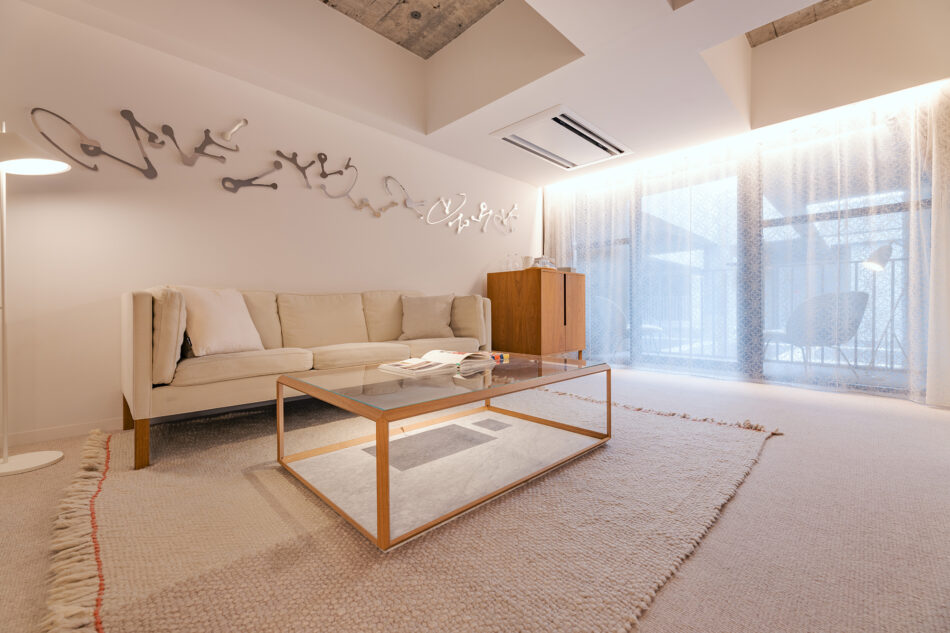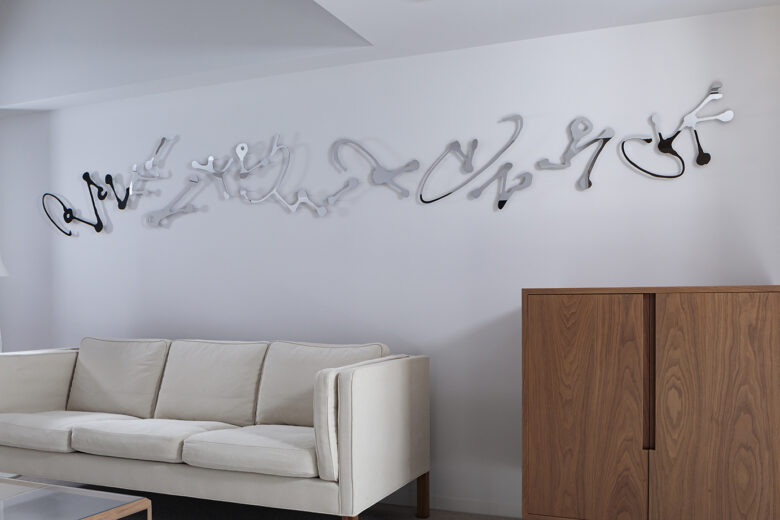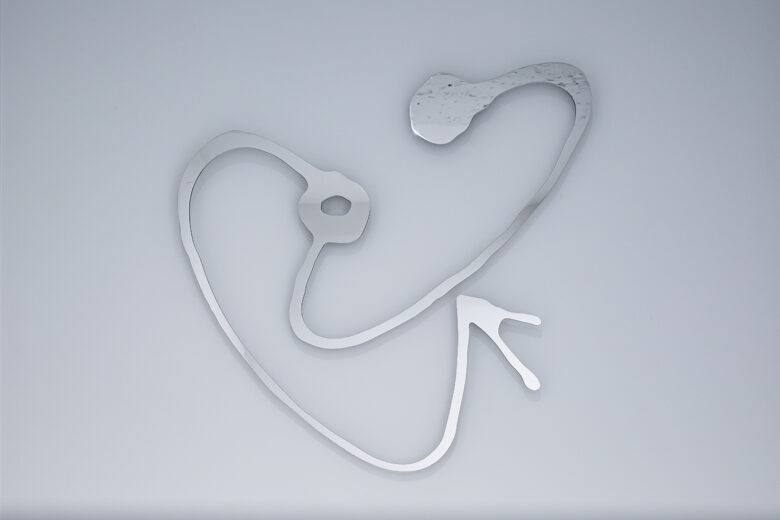ROOM 14 鈴木 ヒラク / HIRAKU SUZUKI



1978年生まれ。東京芸術大学大学院美術研究科修了後、シドニー、サンパウロ、ロンドン、ニューヨーク、ベルリンなどの各地で滞在制作を行う。ドローイングと言語との関係性を主題に、平面・彫刻・映像・写真・パフォーマンスなどから、ドローイングの概念を拡張するような制作活動を展開している。これまでに金沢21世紀美術館(石川、2009年)、森美術館(東京、2010年)、銀川現代美術館(中国、2016年)、MOCO Panacée(フランス、2019年)、東京都現代美術館(東京、2019-2020年)など国内外の美術館で多数の展覧会に参加。2016年よりプラットフォーム『Drawing Tube』を主宰。主な作品集に『GENGA』(2010年)、『SILVER MARKER―Drawing as Excavating』(2020年)などがある。
鈴木自身が自らの仕事を、「離ればなれになってしまった“描く”と“書く”のあいだの闇、そのかなたに明滅する光の記号を見いだし、獲得し続けることである。」と書き記すように鈴木は常に文字とモチーフの間を往来しながら記号としての新しい言語を創造する。本作は、手描きのドローイングをもとにレーザーで切り出された鏡面のステンレス鋼が壁面に浮かび、鑑賞者の視点の移動に伴って、物質(鉱物)と非物質(イメージ)の間に光学的現象を起こす。惑星の軌道や星座を想起させるような点と線の連なりは、新しいカリグラフィ(書字)でもある。人と環境が出会う時に文字が生まれるとするなら、水の流れ、石に描かれた模様や山のシルエットなど、自然の中に散りばめられた形の中に私たちは新たな記号を読み取り、言語を発見することも可能なのではないだろうか。ステンレスの鏡面から発する光の反射から私たちはどんな新しい言語世界を想像することができるだろう。タイトルの《発掘された反射》とは、光が当たることで闇の中に新たな点が発生し、そこから線が生まれ、人がその光を発見することで線の連なりが文字となり言語となる。人間がまさに言語を発見するその瞬間を感じさせる。対面する村田峰紀の鋳造作品に彫りこまれた線が作家の身体性を強く感じさせるのに対し、鈴木の切り出す線は作家個人の身体性を超えて、その先に広がる(広がっていた)過去と未来を結ぶ時間の流れや宇宙的広がりを感じさせてくれる。
Born in 1978. After obtaining M.F.A at Tokyo University of the Arts, Suzuki has participated in residence programs in Sydney, San Paulo, London, New York and Berlin. With the relation of drawing and language as his central theme, Suzuki developed his activities to expand the concept of drawing through composition, sculpture, videography, photography, and performance. He has participated in various exhibitions in and out of Japan such as 21st Century Museum of Contemporary Art, Kanazawa (Ishikawa, 2019); Mori Art Museum (Tokyo, 2010); Yinchuan Museum of Contemporary Art (China, 2016); MOCO Panacée (France, 2019); Museum of Contemporary Art, Tokyo (Tokyo, 2019-2020). Suzuki has been organising a platform for alternative drawing research and practice “Drawing Tube” since 2016. Major publications include “GENGA” (2010) and “SILVER MARKER – Drawing as Excavating” (2020).
Suzuki describes his work as “continuing to seek and acquire the signs of flickering light beyond the darkness that exists between ‘drawing’ and ‘writing’, which have been separated from each other”. He creates a new language by moving back and forth between letters and motifs. In this work, fragments based on handwriting were laser-cut from a stainless steel mirror and hung on the wall, permitting the emergence of an optical phenomenon that shifts between material (mineral) and immaterial (image) depending on the movement of the viewer’s perspective.The sequence of points and lines, which recalls planetary orbits and constellations, is also a new calligraphy.
If writing is born when humans encounter the environment, might it not be possible to find new signs and discover a language in shapes scattered throughout nature, including the flow of water, the patterns on pebbles, and the silhouettes of mountains? What kind of new language can we imagine in the light reflected from the stainless steel mirror?
The title, Excavated Reflections (Planetary Dance), evokes the emergence of new points where the light touches the dark, the creation of lines from there, and this sequence of lines becoming writing and language when humans discover that light. The piece suggests of the exact moment when human beings discovered language. While Mineki Murata’s work powerfully conveys his physicality through the lines engraved in the cast-bronze art, the lines that Suzuki carves out transcend the artist’s individual physicality and evoke cosmic expansion and the flow of time connecting the expanding (expanded) past to the future.

